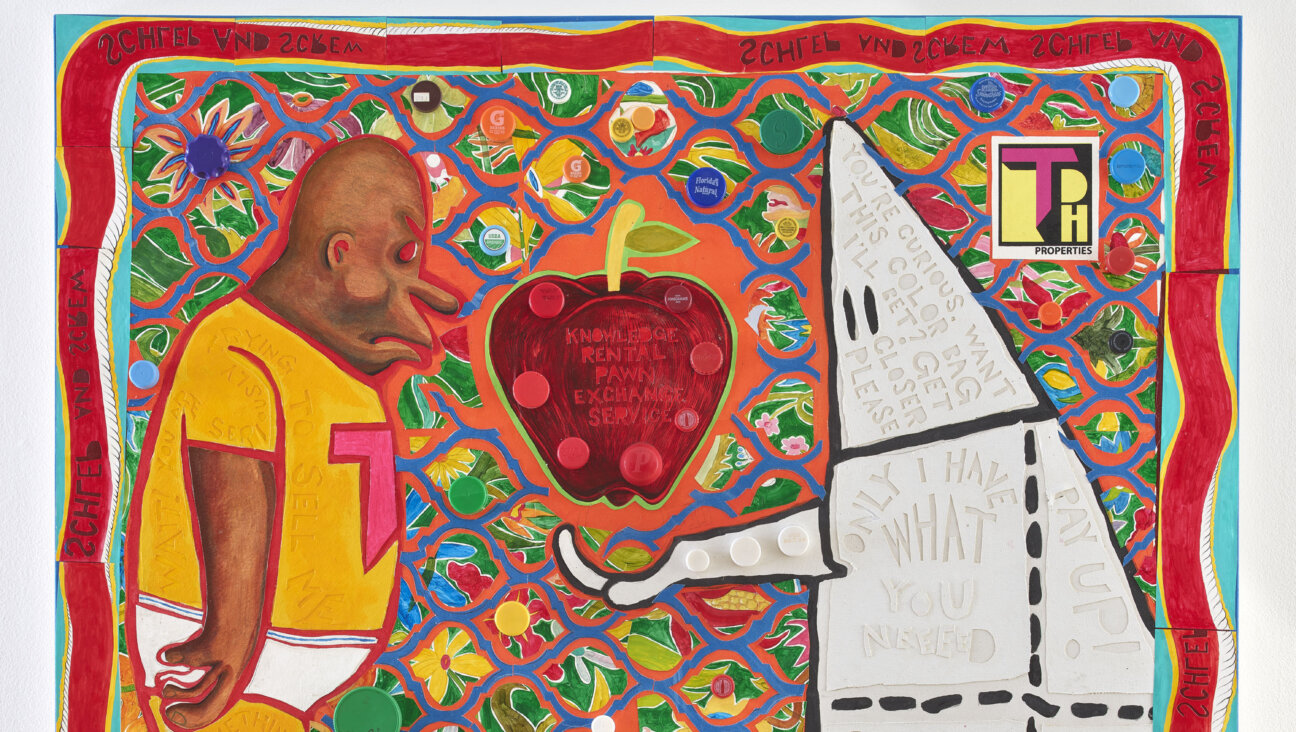Unmasking the Invisible Jews of Budapest

The Hungarian Parliament Image by Getty Images
To paraphrase Mark Twain, “Clothes make the man. Invisible people have little or no influence on society.” Yet Hungarian Jews, because they assimilated into society to the point that most overt Jewish qualities vanished, made a significant cultural impact. This is one thesis of a new book, “The Invisible Jewish Budapest”. Its author, Mary Gluck, is a professor of history and Judaic studies at Brown University. She has also written about the Hungarian Jewish philosopher György Lukács before he became a Marxist, and French modernism. During a recent trip to Budapest, Professor Gluck spoke with “The Forward’s” Benjamin Ivry about this and other paradoxes of Hungarian Jewish experience.
Benjamin Ivry: The Jews of the Austro-Hungarian Monarchy were granted political rights in 1867, and Judaism was declared equal with other religions in 1895. Yet wasn’t this a transient sense of societal acceptance? Karl Lueger, the anti-Semitic mayor of Vienna, derided the city as “Judapest,” showing that bigoted humor does not evolve, preceding today’s references to “Jew York.”
Mary Gluck: It’s a central question. Generally Hungary was considered more favorable for Jewish integration than any other place. There was a kind of schizophrenic situation. There was an explicitly liberal political environment in 1867. By the 1880s it had changed and a really strong nationalist anti-Semitism was introduced. The political and cultural environment was torn.
You explain that Hungarian Jews sought invisibility because they could not see Judaism as a “distinct religious, ethnic, or national identity.” Was such a vision too dangerous at the time?
I think invisibility was a symbolic thing. Jews were very visible, especially in Budapest. Jewish ideas, themes, and jokes were very present. Jews were everywhere. But Jewish presence was uncomfortable for the Hungarian establishment, so officially Jews were not discussed. Jews wanted to assimilate, but in popular culture, [they were] explicitly present.
The humorist Adolf Agai (born Rosenzweig, of Polish Jewish origin; 1836-1916), as analysed in “Budapest and New York,” used the pen name Itzig Spitzig to lampoon Hungarian Jews who in 1875 requested to be called Israelites. Surely Agai understood the quest for social acceptance motivating Hungarian Jews?
Not only was he aware, but he himself was an assimilated Jew. He was a doctor and loved the Hungarian language. He thought Jews should come out of the closet, so to speak, not because he was against assimilation, but he thought this was the healthiest way to assimilate, by not denying Jewish identity. He thought joking would create a better environment for Jewish assimilation if people talked about it, even by exaggerating stereotypes to show how unreasonable they were.

Mary Gluck, author of “The Invisible Jewish Budapest.” Image by University of Wisconsin Press
Analyzing the roughness of Jewish comedy even when created by Jews, the literary historian Aladár Komlós (1892-1980) opined that the “Jewish joke can only be invented by Jews who look at themselves through the eyes of strangers… It is one of the more painful moments of Jewish history when the son of the ghetto first laughs at himself.” Is this the same view of humor as seen on “Curb Your Enthusiasm,” with Susie Essman and Larry David shrieking at each other?
Exactly. I think that Jewish audiences have always felt ambivalence about Jewish comics. This kind of parody, whether Larry David or in the past in a liberal society, shows that Jews feel fairly secure if they can exaggerate their traits in a society willing to give them rights. Some people feel it’s too much, it’s vulgar or possibly politically dangerous, but overall this is a very healthy thing.
There were about 500 coffeehouses in Budapest in 1900. In any of them, were Jews made to feel unwelcome?
They were Jewish coffeehouses. Jews really controlled much of the popular culture in Budapest, including coffeehouses and music halls. The cultural infrastructure of Budapest was very much Jewish. They were not only welcome, they were at home. The only ambivalence about coffeehouses was that Jewish women were not really welcome, because it was felt they were neglecting their domestic duties.
How much of Budapest Jewish coffeehouse nostalgia was hype? The Hungarian Jewish writer Sándor Bródy (1863–1924) claimed that their “atmosphere can be compared to the purest mountain air.” Yet the Hungarian Jewish writer Tamás Kóbor (1867–1942), described in John Lukacs’s “Budapest 1900,” stated: “Smoke saturates [their] atmosphere.” Which was accurate?
They were smoke-filled, but [Bródy] was trying to say it was the ideal space for creativity, better than an aristocratic salon. So Bródy was writing an alternative to Romanticism which depicted the countryside as invigorating; he was saying that the coffeehouse was invigorating.
Studies on Jewish writers in Budapest describe how they met in cafés to discuss jealousies and rivalries. But Hungarian Jewish scientists and mathematicians, such as John von Neumann, collaborated with colleagues in coffeehouses on new ideas. Has the main focus on literature and the fine arts in Budapest coffeehouses overshadowed lasting achievements produced there by Jewish scientists?
That’s a really good question. In the literature on coffeehouses, you rarely encounter scientists. It was a public space for mathematicians too. It’s absolutely plausible that this is the case.
The film of “My Fair Lady” (1964) features Theodore Bikel as Zoltan Karpathy, a Hungarian phonetics expert trained by Henry Higgins, described as a “hairy hound from Budapest.” Alan Jay Lerner’s lyric memorably rhymed Budapest with “ruder pest” to describe Karpathy, exposing people’s true identities by analysing their speech patterns. Could Karpathy be another example of an “invisible” Hungarian Jew, a kind of crypto-Jewish investigator of the legitimacy of other socially pretentious people?
It could be. That’s absolutely right. I think pretentious Hungarian Jews always wanted to hide. The problem was not speech, since they could speak Hungarian flawlessly. But their noses, or their names which they had changed from Jewish-sounding ones to more Hungarian-sounding ones, gave them away.
“The Invisible Jewish Budapest” cites an 1889 play, “The Card Game,” in which Jewish patrons of a Budapest coffeehouse are named Kohn, Lewy, and Brüll. In his memoirs, Gershom Scholem states that his father objected to “The Card Game,” claiming that “such plays promoted antisemitism.’’ Was this because to even mention that Jews exist and sit around a coffeehouse kibitzing was drawing too much attention to them and asking for trouble?
Exactly. It’s the same thing as people objecting to Larry David making Jewish jokes or performing Jewish satire. Scholem’s father didn’t like the exhibition of vulgar Jews making vulgar jokes in public.
The Hungarian Jewish politician Moritz Wahrmann, (1832-1892) was noted for the so-called Jewish ambassador joke, considered witty in the 1890s: “Why does Cohen support the establishment of a Jewish state in Palestine? So he can become Jewish ambassador in Budapest.” This refers to Hungarian Jewry’s patriotism and devotion to Budapest, yet it is hardly a knee-slapper.
You’re absolutely right, it’s not a funny joke but a kind of concentration of a broader existential dilemma. It’s not funny at all.
You add that at the time, “In the world of social relations and collective experience, Jews did in fact function as ambassadors from a non-existent nation.” How so?
No matter how many times Jews were declared equal citizens, they weren’t. They were somehow considered as aliens, never like other Hungarians. They could speak Hungarian perfectly and change their names and socialize with Hungarians, but they were always different. This tension was a source of great creativity and of modernity, because in a way it defines the modern dilemma, that people are never just one thing but many things. People are always strangers in some respect, wherever they are, so Jews in Budapest helped create this modern urban culture. The cultural experience of living in an ambivalent political order could be extremely creative. The kind of Jewish Budapest that was a prototype for urban modernity really comes to an end in 1918, when the political and social conditions for Hungarians change rapidly.
Benjamin Ivry is a frequent contributor to the Forward.
A message from our CEO & publisher Rachel Fishman Feddersen

I hope you appreciated this article. Before you go, I’d like to ask you to please support the Forward’s award-winning, nonprofit journalism during this critical time.
We’ve set a goal to raise $260,000 by December 31. That’s an ambitious goal, but one that will give us the resources we need to invest in the high quality news, opinion, analysis and cultural coverage that isn’t available anywhere else.
If you feel inspired to make an impact, now is the time to give something back. Join us as a member at your most generous level.
— Rachel Fishman Feddersen, Publisher and CEO























